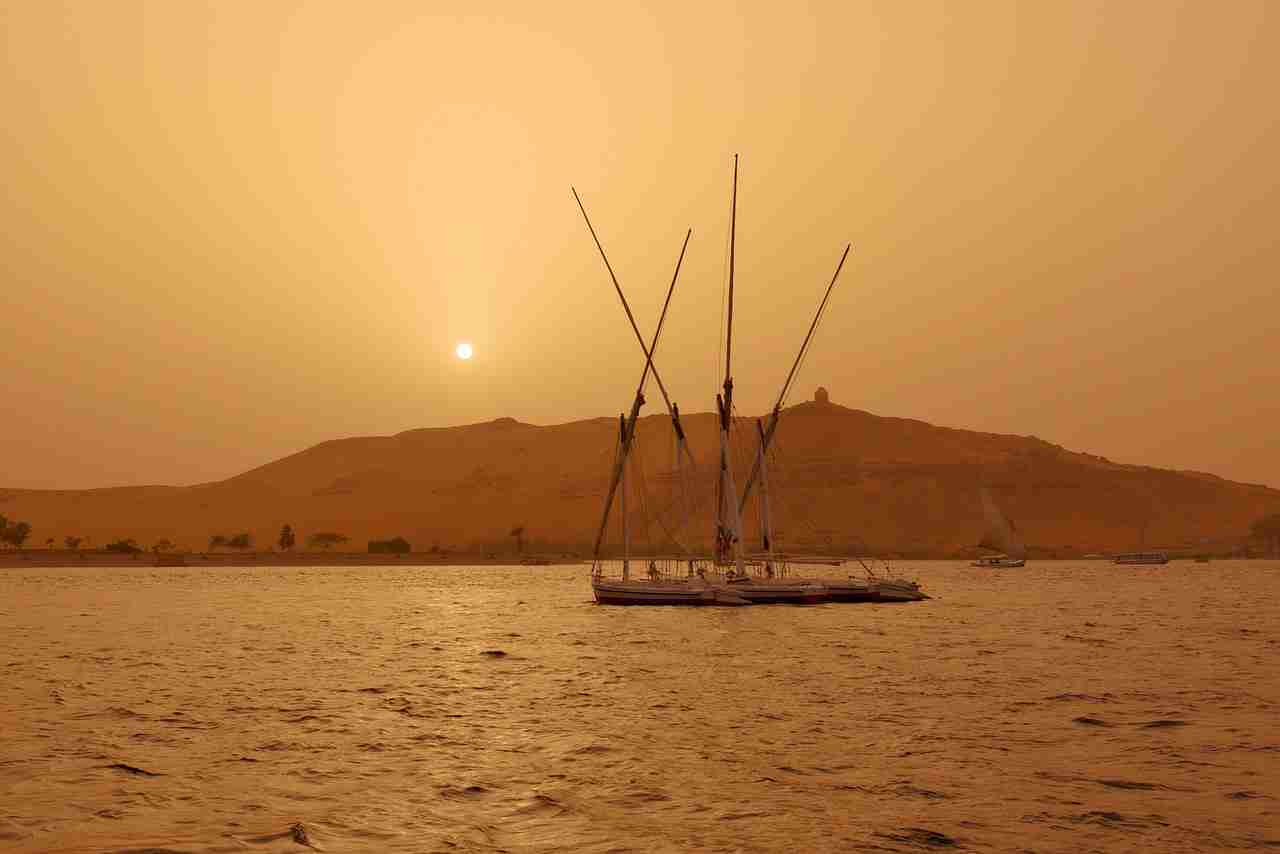24 Facts About The Nile River (You Must Know)
1. The Ancient Egyptians thought the Nile’s annual floods were due to the god Hapi’s joyful tears for the river.
The ancient Egyptians had a grandiose and defining belief about the yearly flooding of the Nile; they believed that it was caused by the tears of joy from the god Hapi.
This grieving figure highly revered his beloved river, expressing such exultant emotion that it ultimately gave way to an annual surge of flood water along its banks.
2. The Nile, at 6,695km, is often recognized as the world’s longest river.
The Nile, stretching approximately 6,695 kilometers, is commonly acknowledged as the world’s longest river, though debates occasionally arise, with some favoring the Amazon at 6,400 kilometers.
This extensive river significantly influences African geography, shaping the histories of civilizations that have flourished along its banks over the ages. The dispute over its status as the longest adds an intriguing dimension to the river’s global recognition.
3. The Nile River has Two Major Tributaries – the White Nile and the Blue Nile.
The Nile River is sourced from two major tributaries: The White Nile and the Blue Nile. These mighty waterways converge in the capital of Sudan, Khartoum, later eddying together and merging before resuming their northward journey towards Egypt.
4. The name Nile may have originated from the Greek word for River Valley (neilos).
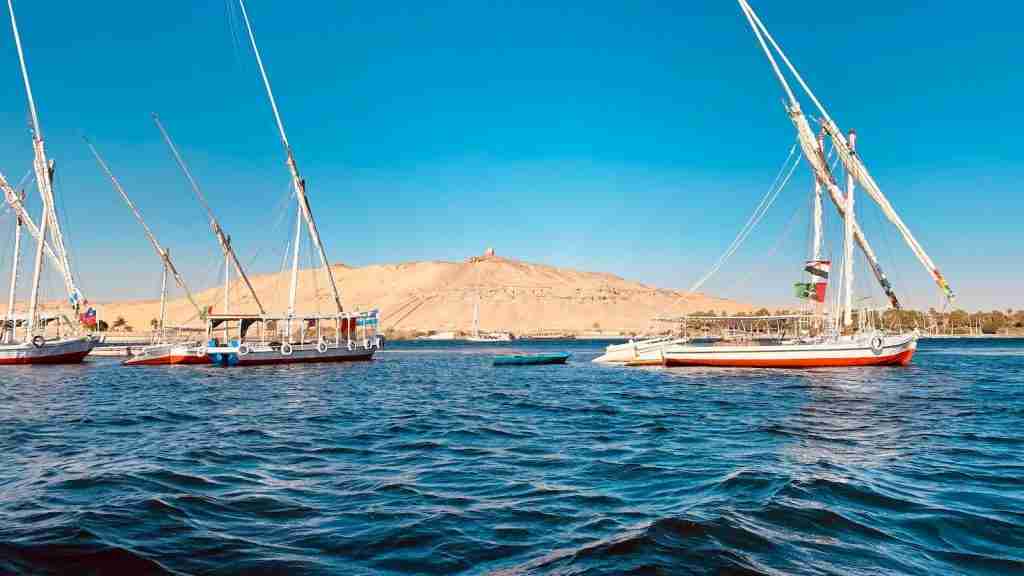
origins of the name Nile.
The Nile River is one of Earth’s most prominent sources, renowned for its cultural, historical, and natural significance. The origin of its iconic name has been derived from Greek; the term nails refers to a river valley.
The length of this unique river has offered many opportunities throughout the years, making it an invaluable asset to the global community as a natural resource for life and vitality.
5. Eleven countries share River Nile waters.
This majestic river touches the territories of all of these countries, connecting them while nourishing their communities with the essential fluids they need.
These eleven nations include Tanzania, Uganda, Rwanda, Burundi, Congo-Kinshasa, Kenya, Ethiopia, Eritrea, South Sudan, Sudan, and Egypt. All depend on the River Nile to provide them with life, cultivating commerce between neighboring countries.
The immensity of this vital source is remarkable and helps their respective economies grow and their citizens lead healthier lives. Just as the Nile is crucial for these nations, the Mississippi plays a similar role in the United States, supporting both commerce and daily life.
6. The Nile Delta, created by silt deposits as the river flows into the Mediterranean.
The Nile Delta has a fascinating origin story; it was formed by rich silt deposits delivered by the mighty river as it travels to meet the Mediterranean Sea. These small granules of minerals and nutrients have made this region one of the most fortunate in terms of fertility levels.
Thanks to this auspicious natural resource, farmers have cultivated this beloved land to cultivate various staple crops over time. This impressive touch from nature has enabled communities around this region to flourish on its useful soil cover, filling humanity with abundance.
7. A Species of Blind Fish known as Niloticus can only be found in the Nile River.
Peculiar creatures lurk in the murky waters of the Nile River, a species of blind fish known as Niloticus. Living fully submersed amongst silt, clay, and sediment, these extraordinary amphibians move amidst the river’s currents and have remained limited to the Nile and its tributaries since ancient times.
Becoming evolutionary adapted over thousands of years, their black fringes split their bodies lengthwise to help detect even slight changes in pressure or vibration in their exceptional sensory receptors.
8. Over 250 species of birds live along the banks of the Nile River.
When it comes to the biodiversity of the Nile River, there are many fascinating facts to uncover. For example, did you know that the Nile is home to over 250 bird species on its banks and marshes?
This diverse range of bird life. In particular, the painted snipe, an exotic breed that is almost extinct elsewhere in the world, has made the River Nile its roaming grounds.
Songbirds from reed warblers to crakes, hoot owls, and bee-eaters flock to this grand river valley, making it a wonderful spectacle.
9. Ancient Egyptians used to mummify crocodiles, which they considered sacred animals.
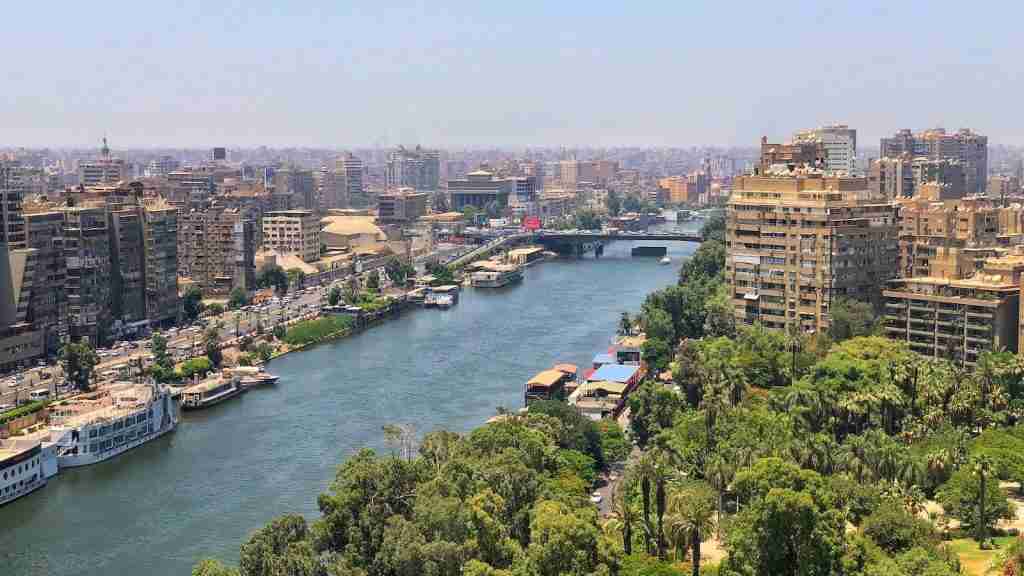
of crocodiles in Ancient Egypt.
The Ancient Egyptians worshipped the crocodile, a sacred animal. They preserved their dead through mummification and placed them in Tombs close to the Nile River.
This practice extended beyond royalty; Kings and Queens were often buried beside cretaceous creatures intact. In numerous cases, several remains were found in the same vicinity –giving archaeologists an opportunity to witness a glimpse fashion of ancient spiritual practices.
10. The Nile River was an important part of Ancient Trade Routes, and Many Cities grew up around it.
In fact, some have even suggested that the famous River Nile gave birth to human civilization as it was known to our ancestors.
From grand edifices standing in modern-day Cairo all the way down its length past Alexandria, Aswan, and numerous smaller settlements in between, its vital contribution to global trade has been experienced since time immemorial.
11. The Nile River was used to Transport Goods such as Pottery, Linen, and Papyrus.
In antiquity, the Nile River served as a major artery for transportation. Goods such as pottery, linen, and papyrus were ferried up and down its length, aiding in the commercial exchange of these goods between villages.
Various civilizations flourished along the banks of the river because it offered an efficient means of transporting these valuable items.
12. Pharaohs often built Temples and Monuments near the Nile River in order to Honor their Gods.
For centuries, Pharaohs have sought to erect impressive Temples and imposing Monuments close to the Nile to show their reverence and honor their Gods.
These sacred sites served as symbols of faithfulness and served as testaments to the Pharaohs’ unwavering devotion to their deities.
13. The Nile is also home to some interesting Flora, including the Giant Water Lily.
Perched near the shore, the almighty Nile River boasts a variety of life, opulent with diversity. Among its most intriguing aquatic inhabitants is the Lily Pad’s Royalty — the Giant Water Lily. Meticulously crafted with life, this majestic flora can reach sizes of up to three feet across.
14. The world’s only Breeding Colonies of Pink Flamingos are found along the banks of the River Nile in Sudan.
The world’s most treasured species, Pink Flamingos, have set up breeding colonies along the banks of the River Nile in Sudan. This sanctuary ensures that future generations can be born amidst serene and tranquil settings for many years to come.
This unique habitat further helps these animal species flourish and participate in their natural environment without human interference.
15. During the flood season, the River Nile waters can reach heights of up to 30 feet in certain areas of Egypt.
Plenty of fascinating natural phenomena can be found along the banks of the Nile River, many of which can be categorized. For example, the Nile quickly awakens under its surface during the rainy season, rising steadily with each transient wave.
As the torrential rains continue, the river begins to swell beyond its banks, resulting in waters that can tower up to 30 feet in height at certain points in Egypt during flood season.
16. The River Nile holds religious importance for many religions.
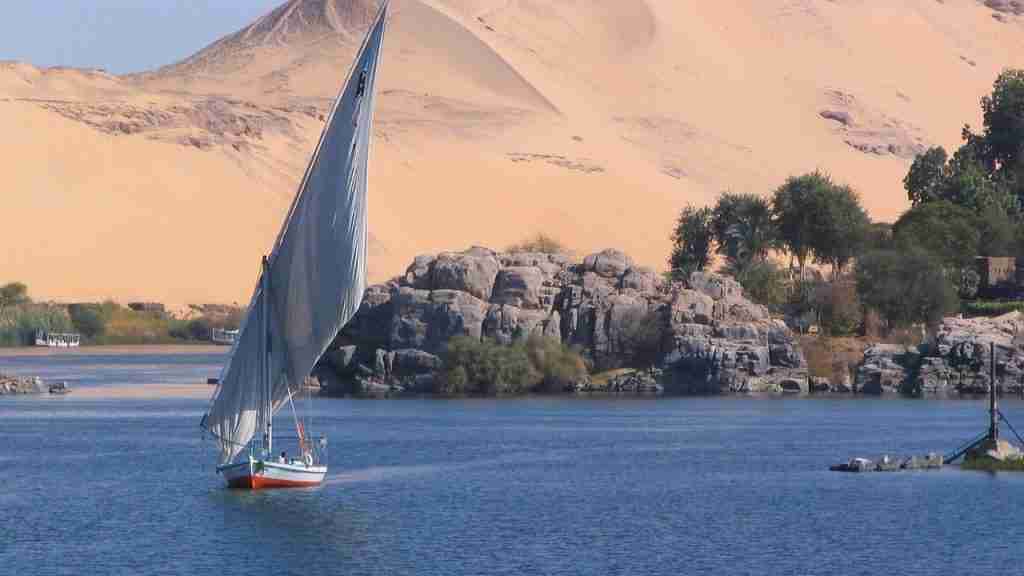
significance across multiple religions.
Predominantly an important feature in Christianity, multiple embarkation scenes aboard ships are narrated on The Nile, notably when Abraham had to sail away with his family.
Another important religious narration involving the River Nile is about the Prophet Moses, who was a leader who faced many tribulations during his lifetime.
As an infant, he found himself discarded by the banks of the River Nile centuries ago. Having been separated from his family and without a home, it seemed his fears had manifested and powerless as he appeared, washed up on its edges.
17. In Ancient Times, two kinds of boats were used on the Nile – Papyrus Reed Boats and Wooden Boats.
In Ancient Times, boats of many shapes and sizes skimmed across the waters of the mighty river Nile. The most prominent types of boats used were Papyrus Reed Boats and Wooden Boats made from Cedar or Acacia wood.
Reed boats utilized a design first developed centuries ago, predating written records. While both types amply served their purpose, papyrus reed boats were light enough for fishermen to load and carry when their vessels ended up aground due to low water levels.
18. The Nile was an important food source for the ancient Egyptians.
The Nile River has long been an integral part of the Ancient Egyptians’ way of life. It provided an important food source for them, with fish such as mullet and eel occupying a particular role in their diet.
The Nile River is an impressive body of water and a vital source of sustenance for millions of people living in Egypt and other parts of Africa.
19. The Aswan Dam generates 15% of Egypt’s electricity.
The Aswan Dam began generating electricity in 1967, initially supplying about half of Egypt’s power, which by 1998 accounted for 15% of the country’s electricity.
This development brought electricity to many villages across Egypt for the first time, significantly enhancing the nation’s energy infrastructure and improving living standards in rural areas.
20. Before the last Ice Age, the Nile flowed west through present-day Libya into the Gulf of Sidra.
In the era preceding the last Ice Age, the Nile River followed a course that extended westward, coursing through the region now identified as Libya and ultimately emptying into the Gulf of Sidra.
This ancient configuration highlights the dynamic geological shifts that have shaped the Nile’s historical trajectory.
The river’s transformative journey, predating the contemporary landscape, underscores the fascinating interplay between natural forces and the ever-evolving features of Earth’s geography.
21. Pharaohs were believed to be sent on the Nile in boats posthumously to reach their afterlife in the heavens.
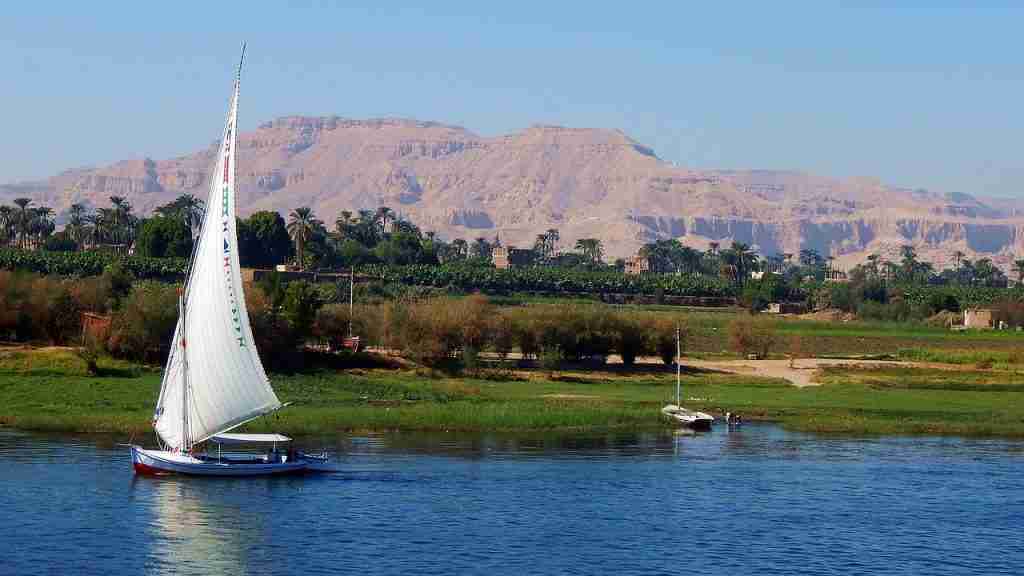
the Nile in search of a heavenly abode.
For centuries, the Pharaohs of Ancient Egypt believed they would continue their journey even in death. Therefore, when a Pharaoh passed away, he was sent down the sacred Nile River in a boat.
With an eye skyward and pointing back at the world of mortals left behind, the vessel descended into the stars.
22. Over 95% of Egypt’s population depends on the Nile.
More than 95% of Egypt’s population relies heavily on the Nile River for their essential needs, including water for drinking, agriculture, and various daily activities.
The river plays a pivotal role in sustaining the livelihoods of the majority of Egyptians, highlighting its unparalleled importance in the region.
23. The Nile’s average depth is 9.5 meters.
With an average depth of 9.5 meters, the Nile River carves its path through the African landscape, showcasing a remarkable blend of breadth and depth.
This substantial depth contributes to the river’s ability to support diverse ecosystems and facilitate the agricultural practices of the communities along its banks.
24. A Nile River cruise sails between Luxor and Aswan, revealing Egypt’s ancient temples.
A Nile River cruise takes you from Luxor to Aswan, showing you Egypt’s old temples. This trip on the river lets you see beautiful places and learn about Egypt’s history.
You get to relax and see important spots between these two famous cities. It’s a special way to see the sights and learn about the past.
FAQS
Yes, the Nile River is the longest river in the world. It is 6,853 km long and considered one of Earth’s longest rivers. The Amazon River in South America is 6,400 km long, while the Yangtze River in China is 6,300 km long.
Yes, there are crocodiles in the Nile River. It is home to two species of large crocodilian, the slender-snouted crocodile and the Nile crocodile. The former is native to Central and Western Africa, where it has been listed as Critically Endangered on the IUCN Red List since 1996 due to overhunting.
The Nile River is a freshwater river. It runs through several different African countries, and its source is Lake Victoria in Rwanda. The water that flows downstream is fresh and un-saline, allowing important species such as fish, reptiles, mammals, amphibians, and birds to thrive along its banks. The only saltwater found near the Nile River is that of the Mediterranean Sea, which it eventually empties into via the Suez Canal.
Yes, you can swim in the Nile River, but there are some safety precautions to keep in mind. The water is relatively safe to swim in if you avoid areas that may be polluted or where wildlife and dangerous currents can be an issue. It’s also important to heed local advice regarding swimming times and places, such as avoiding dark spots of organisms or being aware of any flash floods that may occur during the rainy season.
The Nile River is one of the most famous rivers in the world and has been a source of life, trade, and travel for centuries. Its importance dates back to Ancient Egypt, where it served as the primary source of sustenance for the Pharaohs. Beyond its historical significance, the Nile also boasts tremendous natural beauty. It winds through several different African countries, providing breathtaking landscapes as it passes through mountain ranges and lush greenery.
The Nile River is unique in several ways. It is the longest river in the world and is Egypt’s primary water source and fertile land, making it essential to the country’s survival. The Nile is the only river in the world that flows northward.
The length of the Nile River is approximately 6,650 kilometers (4,130 miles), making it the longest river in the world.
The two primary tributaries of the Nile River are the White Nile and the Blue Nile. The White Nile originates in East Africa, while the Blue Nile originates in Ethiopia. The two tributaries merge in Khartoum, Sudan, to form the main Nile River.

